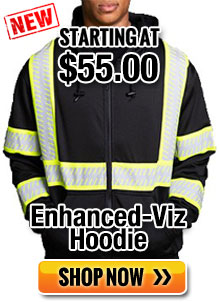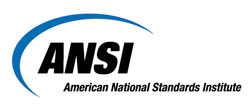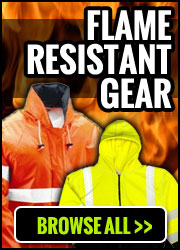
|
Safety Vests
Best Sellers
Made in USA
50-Pack Bulk Cases
Class 2 Safety Vests
Class 3 Safety Vests
Break-Away Vests
Surveyor's Vests
Flame Resistant
Public Safety
Incident Command Vests
Non-ANSI
Women's Safety Vests
Insulated Safety Vests
BROWSE ALL VESTS
T-Shirts
Best Sellers
Class 2 T-Shirts
Class 3 T-Shirts
Long Sleeve
Non-ANSI
Class 1 T-Shirts
Flame Resistant
Made in USA
BROWSE ALL T-SHIRTS
Sweatshirts
Best Sellers
Class 3 Sweatshirts
Crewnecks
Hoodies
Thermal Lined
Non-ANSI
Class 1 Sweatshirts
Flame Resistant
BROWSE ALL SWEATSHIRTS
Outerwear
Best Sellers
Class 3 Outerwear
Windbreakers
Thermal Lined Sweatshirts
Jackets & Parkas
3-in-1 Jackets
Public Safety
Non-ANSI
Insulated Pants & Coveralls
Women's Jackets
Insulated Vests
BROWSE ALL OUTERWEAR
Rainwear
Best Sellers
Rain Jackets
Rain Pants
Bib Overalls
Rainsuits
Long Raincoats
Flame Resistant & Arc Rated
Non-ANSI
Women's Rainwear
BROWSE ALL RAINWEAR
Flame Resistant
FR Safety Vests
FR T-Shirts
FR 3-Button Henleys
FR Sweatshirts
FR Work Shirts
FR Coveralls with Reflective Tape
FR Rainwear
BROWSE ALL FR
Pants, Bibs & Coveralls
Best Sellers
Mesh Pants
Rain Pants
Bib Overalls
Insulated Pants & Bibs
Coveralls
Work Pants
Headwear
Best Sellers
Hard Hats
Baseball Caps
Winter Hats
Ranger Hats
Accessories
BROWSE ALL HEADWEAR
Work Shirts
Class 2 Work Shirts
Class 3 Work Shirts
Flame Resistant & Arc Rated
Non-ANSI
BROWSE ALL WORK SHIRTS
 |
ANSI Safety Apparel Information
The ANSI/ISEA standard establishes a set of performance criteria and provisions for the selection, design, and use of high visibility safety apparel. The standard defines three garment classes based on designs utilizing amounts of precisely specified garment background material and retroreflective material. It also provides guidelines to help purchasers select the appropriate garment based on an assessment of worker hazards and tasks, complexity of the work environment or background, and vehicular traffic and speed. Class 1 garments are intended for use in activities that permit the wearer's full and undivided attention to approaching traffic. There should be ample separation of the worker from traffic, which should be traveling no faster than 25 miles per hour. Examples of workers who use Class 1 garments may include:
Class 2 garments are intended for use in activities where greater visibility is necessary during inclement weather conditions or in work environments with risks that exceed those for Class 1. Garments in this class also cover workers who perform tasks that divert their attention from approaching traffic, or that put them in close proximity to passing vehicles traveling at 25 miles per hour or higher. Examples of workers who use Class 2 garments may include:
Examples of workers who use Class 3 garments may include:
These Performance Class Guidelines are provided as guidance only. Certain specific conditions such as environment, weather, level of training, site-detection distances, regulations, proximity to vehicles, and competing hazards in emergency situations should be considered. Vehicle speed should not be considered in isolation to these factors. PPE properties such as background color should be selected to optimize contrast between the wearer and the work environment. The 2009 MUTCD (Manual on Uniform Traffic Control Devices) requires (1) Class 2 or 3 high visibility apparel for workers on or near public roadways who are not emergency responders, and (2) a risk assessment performed by a qualified safety professional to determine the appropriate garment class. This information is adapted from ISEA/ANSI 107-2010 Appendix B. |


 To address the hazards of low worker visibility during the day, in low-light conditions, and at night, International Safety Equipment Association members developed ANSI/ISEA 107-2010: the American National Standard for High-Visibility Safety Apparel
To address the hazards of low worker visibility during the day, in low-light conditions, and at night, International Safety Equipment Association members developed ANSI/ISEA 107-2010: the American National Standard for High-Visibility Safety Apparel




